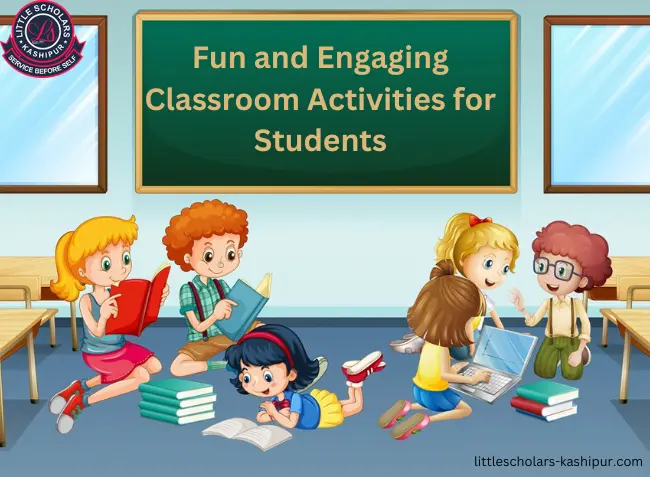Classroom activities play a pivotal role in students' educational journey, fostering academic skills and social, emotional, and creative development. These activities, which range from interactive learning techniques to creative assignments, are designed to engage students actively and make learning more enjoyable. Implementing a variety of classroom activities can help cater to diverse learning styles, encourage collaboration, and enhance overall student participation.
Classroom Activities for Students
Classroom activities for students are crucial for creating an engaging and dynamic learning environment. These activities can be interactive, collaborative, and creative, providing students with opportunities to explore new concepts and apply their knowledge in practical ways.
Interactive Learning
Interactive learning activities involve students in the learning process actively, making lessons more engaging and effective. By incorporating activities such as gamified lessons and role-playing, teachers can create a more immersive educational experience.
Group Projects
Group projects encourage teamwork and collaboration among students. These projects can range from simple tasks to complex assignments that require extensive research and planning. Through group projects, students learn to communicate effectively, delegate tasks, and work towards a common goal.
Creative Assignments
Creative assignments allow students to express their understanding and knowledge in unique ways. These can include art and craft projects, creative writing, and multimedia presentations. Teachers can help students develop critical thinking and problem-solving skills by integrating creativity into the curriculum.
Ice Breakers
Icebreakers are activities designed to help students get to know each other and build a sense of community within the classroom. These activities are particularly useful at the beginning of the school year or when introducing new students to the class.
Interactive Learning Techniques
Gamified Lessons
Gamification involves incorporating game elements into lessons to make learning more engaging. This can include using point systems, leaderboards, and interactive quizzes. Gamified lessons motivate students to participate actively and can make challenging subjects more enjoyable.
Role-Playing
Role-playing activities allow students to step into different characters' shoes, helping them understand various perspectives and develop empathy. This technique is particularly effective in subjects like history and literature, where students can reenact historical events or literary scenes.
Technology Integration
Incorporating technology into classroom activities can enhance learning experiences. Tools such as interactive whiteboards, educational apps, and online resources provide students with new ways to engage with the material. Technology can also facilitate virtual field trips and digital storytelling.
The Effect of Arts Education on Student Development
Group Projects and Collaborations
Project-Based Learning
Project-based learning (PBL) involves students working on projects over an extended period, culminating in a final product or presentation. PBL encourages students to research, problem-solve, and apply their knowledge to real-world situations.
Peer Reviews
Peer review sessions allow students to give and receive feedback on each other’s work. This process helps students develop critical thinking and communication skills and fosters a collaborative learning environment.
Group Discussions
Group discussions provide students with opportunities to share ideas and debate topics. These discussions can be structured or open-ended, encouraging students to think critically and articulate their thoughts clearly.
Creative Classroom Activities
Art and Craft
Art and craft activities enable students to express their creativity while learning. These activities can be integrated into various subjects, such as creating historical dioramas in history class or illustrating concepts in science.
Storytelling
Storytelling activities help students develop language skills and imagination. Students can write and share their own stories, participate in storytelling circles, or create digital storybooks.
Drama and Theatre
Drama and theatre activities engage students in acting, scriptwriting, and stage production. These activities build confidence, improve public speaking skills, and foster teamwork.
Ice Breaker Activities
Name Games
Name games help students learn each other’s names and build initial connections. Simple activities like name chains or name games with rhymes can make introductions fun and memorable.
Fun Facts
Sharing fun facts is a light-hearted way for students to learn more about each other. Each student can share an interesting fact about themselves, sparking conversations and curiosity.
Team Building Exercises
Team building exercises strengthen the sense of community and cooperation among students. Activities such as trust falls, group puzzles and collaborative challenges encourage teamwork and problem-solving.
The Role of Physical Education in Academic Achievement
Utilizing Technology in Classroom Activities
Digital Presentations
Digital presentations allow students to showcase their knowledge using multimedia tools. Platforms like PowerPoint, Prezi, and Google Slides enable students to create engaging and visually appealing presentations.
Virtual Field Trips
Virtual field trips provide students with immersive experiences without leaving the classroom. Using VR technology or online resources, students can explore museums, historical sites, and natural wonders from around the world.
Online Quizzes
Online quizzes offer a fun and interactive way to assess student understanding. Platforms like Kahoot!, Quizlet, and Socrative allow teachers to create custom quizzes that students can complete individually or in groups.
Project-Based Learning
Real-World Problems
Addressing real-world problems through projects helps students apply their knowledge to practical situations. Projects can involve community issues, environmental challenges, or global topics, encouraging students to think critically and creatively.
Research Projects
Research projects develop students' investigative skills and deepen their understanding of specific topics. Students can explore subjects of interest, gather information from various sources, and present their findings.
Community Projects
Community projects connect classroom learning with the local community. These projects can involve service-learning, where students volunteer or work on initiatives that benefit their community.
Storytelling and Drama
Interactive Storytelling
Interactive storytelling involves students participating in the creation and telling of stories. This can include writing collaborative stories, using story maps, or engaging in storytelling games.
Improvisation
Improvisation activities encourage students to think on their feet and be creative. Improv games and exercises help students develop quick thinking and spontaneous communication skills.
Script Writing
Scriptwriting projects allow students to create their own plays or skits. This activity combines creative writing, planning, and performance skills, culminating in a class production or presentation.
Benefits of Classroom Activities
Classroom activities offer numerous benefits, enhancing student engagement, skill development, and social interaction. These activities create a dynamic learning environment where students feel motivated and involved.
Enhanced Engagement
Engaging in classroom activities captures students' interest and makes learning enjoyable. Active participation in various activities keeps students attentive and motivated to learn.
Skill Development
Through diverse classroom activities, students develop essential skills such as critical thinking, problem-solving, communication, and creativity. These skills are crucial for their academic and personal growth.
Social Interaction
Classroom activities promote social interaction and teamwork. Students learn to collaborate, share ideas, and support each other, building a strong sense of community and camaraderie.
10 things you should know about personal learning environments
Conclusion
Classroom activities encompass a wide range of educational and interactive exercises designed to enhance learning experiences. From interactive lessons and group projects to creative assignments and icebreakers, these activities play a crucial role in student development. By engaging students in diverse activities, teachers can create a vibrant and inclusive classroom environment.




